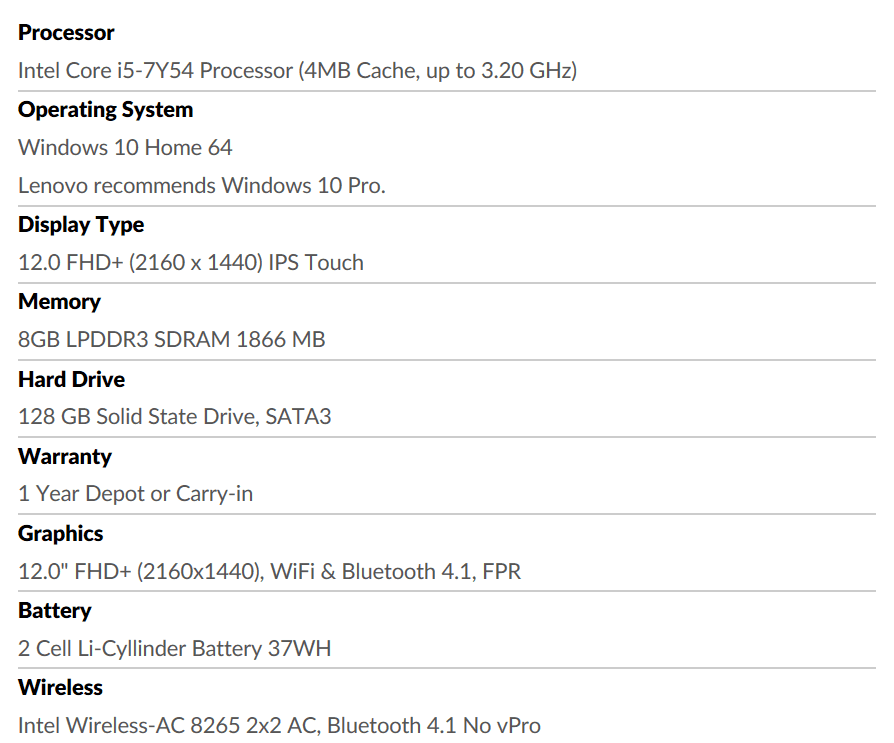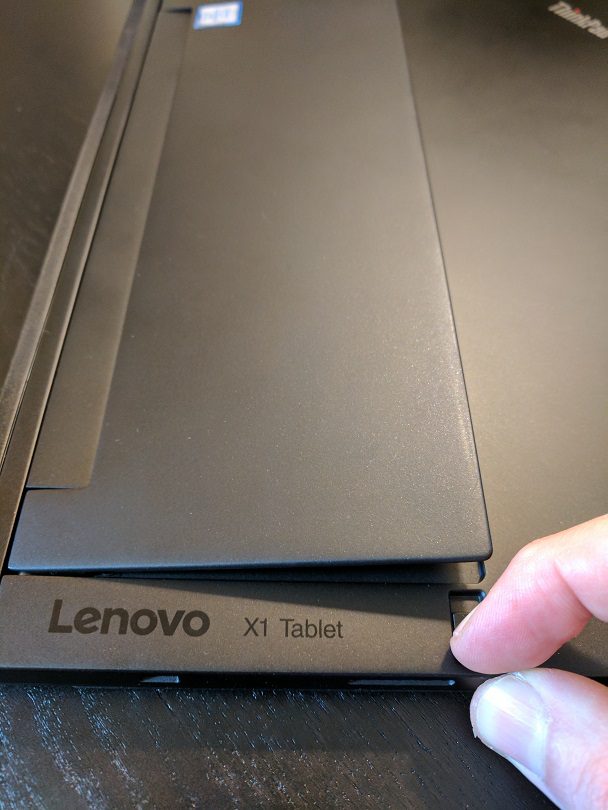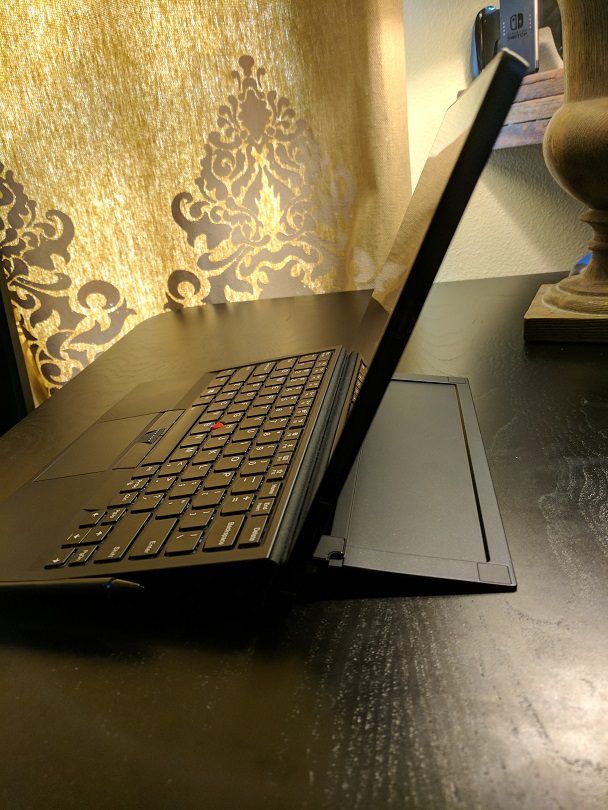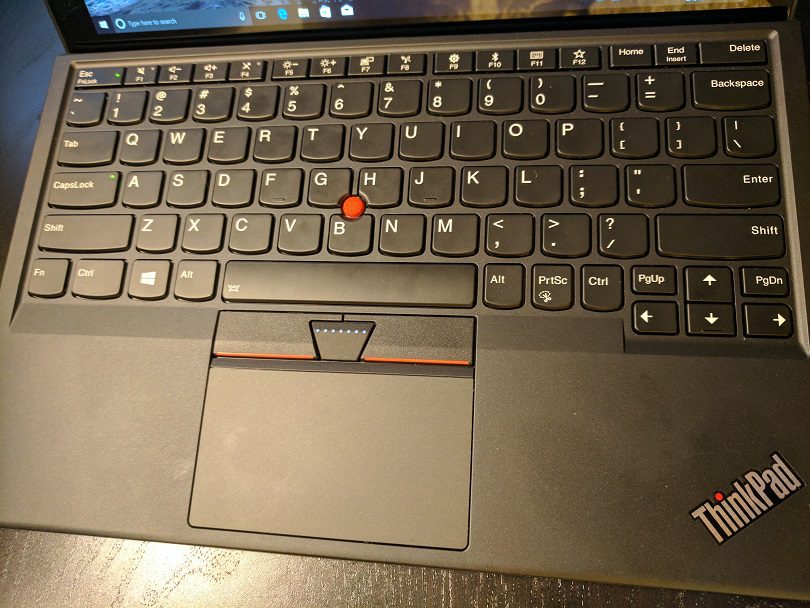Special thanks to Lenovo for providing this demo unit.
The ThinkPad X1 Tablet (“X1”) has a sharp display and enough horsepower to rock your business world. It’s a convertible 2-in-1 laptop/tablet hybrid that is targeted at business users. It’s detachable keyboard carries the brand and comfort of Lenovo’s classic ThinkPad laptops – even the red TouchPoint nub in the center. Outside of that, it’s a Surface Pro competitor and the best attempt I’ve seen. Microsoft’s Surface business generates revenues in excess of $1B per year and has helped propel Microsoft into the hardware world in a way that surprised me. While that revenue mark is not exclusive to the Surface tablet, a good portion is and that’s why Lenovo translated their business-dominant ThinkPad line into a Surface tablet-like device.
Hardware reviewers, such as myself, spend too much time classifying and segmenting devices. We say they’re for gamers, students, couch-surfing, business users, etc. In reality, the Venn diagram associated with these classifications relative to hardware capabilities, is really not all that diverse. To say the X1 is a “business user” tablet, is being too limited. The X1 is excellent for these tasks:
- document creation
- web browsing & social media
- media consumption & web conferencing
- light gaming
Document Creation
As per usual, with any laptop review, I am writing this review using the device itself. Thus, document creation. My experience centers entirely around the keyboard, which is excellent. I’ve owned every Surface keyboard and this is easily the best tablet keyboard I’ve used. It’s included with the X1 at purchase but is unfortunately only compatible with the X1. The chicklet keys are comfortable with good feedback and little flex. The backlight works well but I’d prefer if the characters on the keys themselves had light coming through them. There is a satisfying soft touch with the press of each key. Functionally you get volume and display brightness control as alternatives to the standard f-keys. There’s also Wi-Fi and Bluetooth control. My favorite key, other than mute, is the F-12 alternative “star” key. With this you can use Lenovo’s Keyboard Manager application to assign an action to it. I use it to open File Manager. I’m a geek, remember? What really bugs me about the keyboard are the dedicated home and end buttons. I know! I should be happy about that. But as a fairly fast typist I like to keep my fingers on the home row and my thumbs near the trackpad. The dedicated home and end keys are far enough away that I need to move my right hand away from the home row. What Microsoft has done with it’s Surface keyboards is a quick combo of function+arrow (left or right) to replace home and end. I love that.
Alright – there is one more issue I have with the keyboard: Why are there arrows at all? I can’t blame Lenovo – this is legacy nonsense for Windows machines. Just like Apple OS uses the enter key to rename files and folders. It’s archaic, asinine, and needs to go away. Moving on…
Web Browsing & Social Media
In the context of other Windows 10 tablets and laptops, the X1 is a rock star. But Windows 10 itself is a limitation for those who want a keyboard-free browsing experience. I suppose it depends on which types of sites you visit. If you’re a regular here at GWW, you rarely need a keyboard. If you have to type, Windows 10’s soft keyboard is fine for light use. But it can really strain your hands with considerable use. If you can live in a keyboard-light world of web browsing, you’ll be comfortable here. The screen is bright, responsive, and the machine is fast. Lenovo crammed a seventh-gen Intel Core i5 into a 0.3″ thick chassis. It’s impressive, but a new normal. If you’re expecting to marathon on the couch all-day, the X1 won’t quite get you there. I clocked 5 hours and 5 minutes of general use with the screen at 50% brightness and the keyboard connected and mostly in use.
Media Consumption & Web Conferencing
Taking center stage is the X1’s 12 inch IPS display with a 2160 x 1440 resolution. The pixel density is acceptable and good for watching movies. I find the brightness to be excellent, although others may disagree. This is always an area of debate between users. For example, I watched videos from our Streamers Sanctorum in a lightly-lit room with the display brightness at 25%. I had to dial it down to reduce eye strain. The speakers fire from the sides and are passable. I attended several web conferences using GoToMeeting and there weren’t any complaints about my microphone. However, when I tested the microphone myself, I found it below average. Your mileage may vary. I did take the X1 out on four short flights (less than an hour each). I hooked up the X1 to my Bose QC35 headphones via Bluetooth and enjoyed the experience more than on my NVIDIA Shield Tegra X1 (no relation) 7 inch tablet. These are not comparable products but it does emphasize an overlooked value with hybrids such as the Surface and X1: you don’t need a tablet. Sure, Android is a better tablet experience than Windows 10, but is it really worth carrying a dedicated device for? My advice: save the $200 – $600 and put it towards a hybrid if you really don’t want a gaming laptop.
Light Gaming
I played Hearthstone – ok a lot of Hearthstone – and it was glorious. No frame drops and it looked excellent. Hearthstone is a casual game, in my opinion. And that is exactly the island of the gaming world where you’ll be living if you game on the X1. I also played Kingdoms and Castles, which is a new game (released July, 2017) but not demanding graphically. When I fired up Overwatch I had to make some graphical sacrifices to ensure a playable experience. At the low end my FPS bottomed out at 25 FPS and averaged 47. But without anti-aliasing or a higher resolution, it’s just not fun to play when you’re shooting at blurry enemies. Here is what I settled with:
- Resolution: 1440 x 900 (60)
- Field of View: 103
- Aspect Ratio: 16:9
- VSYNC: off
- Triple Buffering: off
- Reduce Buffering: off
- Limit FPS: 30
- Graphics Quality: low
Remember I wrote “playable”? This isn’t an ideal experience. The X1 is not a gaming machine , which not a surprise to me. But it’s always fun to test the graphical limits. Older games like Portal 2 ran perfectly with 60 FPS at 1080p with all settings on max. That’s not a bad consolation prize if you like to game and travel lightly.
Specifications
Lenovo’s website shows several configuration options for the CPU, OS, RAM and storage. Regarding storage, you can select from 128GB SSD up to 1TB NVM-e PCIe SSD. The CPU and RAM are tethered together:
- Intel Core M7 6Y75 vPRO Processor with 16GB of RAM onboard
- Intel Core M7 6Y75 vPRO Processor with 8GB of RAM onboard
- Intel Core M5 6Y57 vPRO Processor with 8GB of RAM onboard
- Intel Core M5 6Y57 vPRO Processor with 4GB of RAM onboard
- Intel Core M5 6Y54 Processor with 8GB of RAM onboard
Additional ports:
- 1 x USB 3.0
- 1 x USB Type-C Power Delivery
- Mini DisplayPort
- microSD
- Nano Sim

Our unit’s specifications
The X1 weighs in at 1.7 lbs without the keyboard and 2.3 lbs with the keyboard. Really, anything under 3 lbs is ultra portable. You likely will put it in a sleeve or at least your backpack or over-the-shoulder/messenger bag. The X1 won’t add much weight or stress to your person. I hardly noticed it while traveling with it in my backpack.
Wrap Up
The Lenovo Thinkpad X1 (gen 2) is an excellent 2-in-1 that offers a premium, business-class typing experience in a mid-range technology package. Starting at $1,149, it’s a solid package that includes the X1 along with a pen and keyboard. The X1 is effectively the Surface Pro 4 with a business touch that echoes the ThinkPad line, that has become synonymous with quality business laptops. The big pluses: USB-C charging, bright screen, good battery life, and a fantastic keyboard. On the other hand, the X1 is expensive. Granted, it’s less expensive than a similarly priced Surface Pro 4, after adding a pen and keyboard. Regardless of that fact, it’s still as much as a Dell XPS 13 or Surface Laptop. It’s selling point is it’s more versatile, but the limitation to that claim is Windows 10. If you’re a fan of the Surface hybrids and you want a less expensive option that looks and feels like a traditional ThinkPad, then the X1 is for you.






